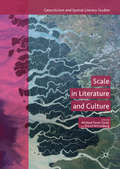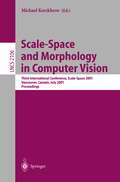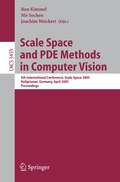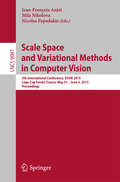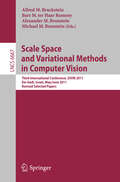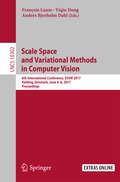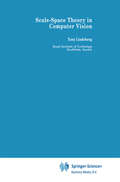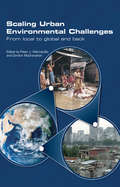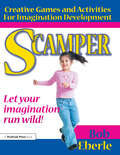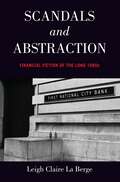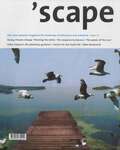- Table View
- List View
Scale in Literature and Culture
by Michael Tavel Clarke David WittenbergThis collection emphasizes a cross-disciplinary approach to the problem of scale, with essays ranging in subject matter from literature to film, architecture, the plastic arts, philosophy, and scientific and political writing. Its contributors consider a variety of issues provoked by the sudden and pressing shifts in scale brought on by globalization and the era of the Anthropocene, including: the difficulties of defining the concept of scale; the challenges that shifts in scale pose to knowledge formation; the role of scale in mediating individual subjectivity and agency; the barriers to understanding objects existing in scalar realms different from our own; the role of scale in mediating the relationship between humans and the environment; and the nature of power, authority, and democracy at different social scales.
Scale-Space and Morphology in Computer Vision: Third International Conference, Scale-Space 2001, Vancouver, Canada, July 7-8, 2001. Proceedings (Lecture Notes in Computer Science #2106)
by Michael KerckhoveThis book constitutes the refereed proceedings of the Third International Conference on Scale-Space and Morphology in Computer Vision, Scale-Space 2001, held in Vancouver, Canada in July 2001.The 18 revised full papers presented together with 23 posters were carefully reviewed and selected from 60 submissions. The book addresses all current aspects of scale-space and morphology in the context of computer vision, in particular, vector distance functions, optic flow, image registration, curve evolution, morphological segmentation, scalar images, vector images, automatic scale selection, geometric diffusion, diffusion filtering, image filtering, inverse problems, active contours, etc.
Scale Space and PDE Methods in Computer Vision: 5th International Conference, Scale-Space 2005, Hofgeismar, Germany, April 7-9, 2005, Proceedings (Lecture Notes in Computer Science #3459)
by Ron Kimmel Nir Sochen Joachim WeickertWelcome to the proceedings of the 5th International Conference on Scale-Space and PDE Methods in Computer Vision. The scale-space concept was introduced by Iijima more than 40 years ago and became popular later on through the works of Witkin and Koenderink. It is at the junction of three major schools of thought in image processing and computer vision: the design of ?lters, axiomatic approaches based on partial di?erential equations (PDEs), and variational methods for image regularization. Scale-space ideas belong to the mathematically best-understood approaches in image analysis. They have entered numerous successful applications in medical imaging and a number of other ?elds where they often give results of very high quality. This conference followed biennial meetings held in Utrecht, Corfu, Vancouver and Skye. It took place in a little castle (Schl¨ osschen Sch¨ onburg) near the small town of Hofgeismar, Germany. Inspired by the very successful previous meeting at Skye, we kept the style of gathering people in a slightly remote and scenic place in order to encourage many fruitful discussions during the day and in the evening. Wereceived79fullpapersubmissionsofahighstandardthatischaracteristic for the scale-space conferences. Each paper was reviewed by three experts from the Program Committee, sometimes helped by additional reviewers. Based on theresultsofthesereviews,53paperswereaccepted.Weselected24manuscripts for oral presentation and 29 for poster presentation.
Scale Space and Variational Methods in Computer Vision: 5th International Conference, SSVM 2015, Lège-Cap Ferret, France, May 31 - June 4, 2015, Proceedings (Lecture Notes in Computer Science #9087)
by Jean-François Aujol Mila Nikolova Nicolas PapadakisThis book constitutes the refereed proceedings of the 5th International Conference on Scale Space and Variational Methods in Computer Vision, SSVM 2015, held in Lège-Cap Ferret, France, in May 2015. The 56 revised full papers presented were carefully reviewed and selected from 83 submissions. The papers are organized in the following topical sections: scale space and partial differential equation methods; denoising, restoration and reconstruction, segmentation and partitioning; flow, motion and registration; photography, texture and color processing; shape, surface and 3D problems; and optimization theory and methods in imaging.
Scale Space and Variational Methods in Computer Vision: Third International Conference, SSVM 2011, Ein-Gedi, Israel, May 29 -- June 2, 2011, Revised Selected Papers (Lecture Notes in Computer Science #6667)
by Michael M. Bronstein Alfred M. Bruckstein Bart M. Ter Haar Romeny Alexander M. BronsteinThis book constitutes the thoroughly refereed post-conference proceedings of the Third International Conference on Scale Space Methods and Variational Methods in Computer Vision, SSVM 2011, held in Ein-Gedi, Israel in May/June 2011. The 24 revised full papers presented together with 44 poster papers were carefully reviewed and selected from 78 submissions. The papers are organized in topical sections on denoising and enhancement, segmentation, image representation and invariants, shape analysis, and optical flow.
Scale Space and Variational Methods in Computer Vision: 4th International Conference, SSVM 2013, Schloss Seggau, Graz, Austria, June 2-6, 2013, Proceedings (Lecture Notes in Computer Science #7893)
by Arjan Kuijper Kristian Bredies Thomas Pock Horst BischofThis book constitutes the refereed proceedings of the 4th International Conference on Scale Space Methods and Variational Methods in Computer Vision, SSVM 2013, held in Schloss Seggau near Graz, Austria, in June 2013. The 42 revised full papers presented were carefully reviewed and selected 69 submissions. The papers are organized in topical sections on image denoising and restoration, image enhancement and texture synthesis, optical flow and 3D reconstruction, scale space and partial differential equations, image and shape analysis, and segmentation.
Scale Space and Variational Methods in Computer Vision: 6th International Conference, SSVM 2017, Kolding, Denmark, June 4-8, 2017, Proceedings (Lecture Notes in Computer Science #10302)
by François Lauze Yiqiu Dong Anders Bjorholm DahlThis book constitutes the refereed proceedings of the 6th International Conference on Scale Space and Variational Methods in Computer Vision, SSVM 2017, held in Kolding, Denmark, in June 2017. The 55 revised full papers presented were carefully reviewed and selected from 77 submissions. The papers are organized in the following topical sections: Scale Space and PDE Methods; Restoration and Reconstruction; Tomographic Reconstruction; Segmentation; Convex and Non-Convex Modeling and Optimization in Imaging; Optical Flow, Motion Estimation and Registration; 3D Vision.
Scale Space and Variational Methods in Computer Vision: 7th International Conference, SSVM 2019, Hofgeismar, Germany, June 30 – July 4, 2019, Proceedings (Lecture Notes in Computer Science #11603)
by Jan Lellmann Martin Burger Jan ModersitzkiThis book constitutes the proceedings of the 7th International Conference on Scale Space and Variational Methods in Computer Vision, SSVM 2019, held in Hofgeismar, Germany, in June/July 2019. The 44 papers included in this volume were carefully reviewed and selected for inclusion in this book. They were organized in topical sections named: 3D vision and feature analysis; inpainting, interpolation and compression; inverse problems in imaging; optimization methods in imaging; PDEs and level-set methods; registration and reconstruction; scale-space methods; segmentation and labeling; and variational methods.
Scale Space and Variational Methods in Computer Vision: Second International Conference, SSVM 2009, Voss, Norway, June 1-5, 2009. Proceedings (Lecture Notes in Computer Science #5567)
by Marius Lysaker Knut-Andreas Lie Xue-Cheng Tai Knut MorkenThis book contains 71 original, scienti?c articles that address state-of-the-art researchrelatedto scale space and variationalmethods for image processing and computer vision. Topics covered in the book range from mathematical analysis of both established and new models, fast numerical methods, image analysis, segmentation, registration, surface and shape construction and processing, to real applications in medical imaging and computer vision. The ideas of scale spaceandvariationalmethodsrelatedtopartialdi?erentialequationsarecentral concepts. The papers re?ect the newest developments in these ?elds and also point to the latest literature. All the papers were submitted to the Second International Conference on Scale Space and Variational Methods in Computer Vision, which took place in Voss, Norway, during June 1–5, 2009. The papers underwent a peer review process similar to that of high-level journals in the ?eld. We thank the authors, the Scienti?c Committee, the Program Committee and the reviewers for their hard work and helpful collaboration. Their contribution has been crucial for the e?cient processing of this book, and for the success of the conference.
Scale Space and Variational Methods in Computer Vision: First International Conference, SSVM 2007, Ischia, Italy, May 30 - June 2, 2007, Proceedings (Lecture Notes in Computer Science #4485)
by Fiorella Sgallari Almerico Murli Nikos ParagiosThis book constitutes the refereed proceedings of the First International Conference on Scale Space Methods and Variational Methods in Computer Vision, SSVM 2007, emanated from the joint edition of the 4th International Workshop on Variational, Geometric and Level Set Methods in Computer Vision, VLSM 2007 and the 6th International Conference on Scale Space and PDE Methods in Computer Vision, Scale-Space 2007, held in Ischia Italy, May/June 2007.
Scale Space Methods in Computer Vision: 4th International Conference, Scale-Space 2003, Isle of Skye, UK, June 10-12, 2003, Proceedings (Lecture Notes in Computer Science #2695)
by Lewis D. Griffin Martin LillholmThe refereed proceedings of the 4th International Conference on Scale Space Methods in Computer Vision, Scale-Space 2003, held at Isle of Skye, UK in June 2003. The 56 revised full papers presented were carefully reviewed and selected from 101 submissions. The book offers topical sections on deep structure representations, scale space mathematics, equivalences, implementing scale spaces, minimal approaches, evolution equations, local structure, image models, morphological scale spaces, temporal scale spaces, shape, and motion and stereo.
Scale-Space Theories in Computer Vision: Second International Conference, Scale-Space'99, Corfu, Greece, September 26-27, 1999, Proceedings (Lecture Notes in Computer Science #1682)
by Mads Nielsen Peter Johansen Ole F. Olsen Joachim WeickertThis volume constitutes the refereed proceedings of the Second International Conference on Scale-Space Theories in Computer Vision, Scale-Space'99, held in Corfu, Greece, in September 1999.The 36 revised full papers and the 18 revised posters presented in the book were carefully reviewed and selected from 66 high-quality submissions. The book addresses all current aspects of this young and active field, in particular geometric Image flows, nonlinear diffusion, functional minimization, linear scale-space, etc.
Scale-Space Theory in Computer Vision (The Springer International Series in Engineering and Computer Science #256)
by Tony LindebergThe problem of scale pervades both the natural sciences and the vi sual arts. The earliest scientific discussions concentrate on visual per ception (much like today!) and occur in Euclid's (c. 300 B. C. ) Optics and Lucretius' (c. 100-55 B. C. ) On the Nature of the Universe. A very clear account in the spirit of modern "scale-space theory" is presented by Boscovitz (in 1758), with wide ranging applications to mathemat ics, physics and geography. Early applications occur in the cartographic problem of "generalization", the central idea being that a map in order to be useful has to be a "generalized" (coarse grained) representation of the actual terrain (Miller and Voskuil 1964). Broadening the scope asks for progressive summarizing. Very much the same problem occurs in the (realistic) artistic rendering of scenes. Artistic generalization has been analyzed in surprising detail by John Ruskin (in his Modern Painters), who even describes some of the more intricate generic "scale-space sin gularities" in detail: Where the ancients considered only the merging of blobs under blurring, Ruskin discusses the case where a blob splits off another one when the resolution is decreased, a case that has given rise to confusion even in the modern literature.
Scalextric (Shire Library #572)
by Jon MountfortScalextric, the ultimate boys' toy, arrived in toyshops in 1957. The first-ever electric slot-car system, with uncontrollable tinplate cars running on heavy rubber track, it brought the speed and glamour of motor racing to suburban living rooms. Classic marques of the day such as Aston Martin, Jaguar and Lotus featured in the early '60s scalextric sets, and over the years that followed all the classic Formula 1 battles were re-created in schoolboy form, followed by sports cars, rally cars, and classic film re-creations such as the James Bond set of 1968, Batman and Knight Rider.
Scaling Urban Environmental Challenges: From Local to Global and Back
by Peter J Marcotullio Gordon McGranahan?Think globally, act locally? emphasizes the importance of scale in dealing with environmental challenges, but not how to factor it in. This major new book focuses on the spatial dimensions of urban environmental burdens, showing how important it is to take these into account when pursuing environmental justice and good governance - whether in the context of the sanitary risks of slum living, the pollution of uncontrolled industrialization and motorization, or the enormous ecological footprints of affluent urban lifestyles. Written by leading experts in the fields of urban development and environmental planning, the book reviews the urban environmental shifts that have shaped today?s challenges, and examines conditions and problems in the urban centres of low-, middle- and high-income countries. Case studies address such economically diverse cities as Accra, New Delhi, Mexico City and Manchester, while thematic chapters explore issues including water, sanitation and transportation. The book concludes by exploring and analysing different scales of governance. The editors argue that we should not rely solely on local governance to address local burdens like poor sanitation, nor depend only on global governance for global challenges such as greenhouse gas emissions, but that scale is crucial in both understanding the problems and devising successful responses. Published with UNU-IAS and IIED.
Scaling Urban Environmental Challenges: From Local to Global and Back
by Peter J Marcotullio Gordon McGranahan?Think globally, act locally? emphasizes the importance of scale in dealing with environmental challenges, but not how to factor it in. This major new book focuses on the spatial dimensions of urban environmental burdens, showing how important it is to take these into account when pursuing environmental justice and good governance - whether in the context of the sanitary risks of slum living, the pollution of uncontrolled industrialization and motorization, or the enormous ecological footprints of affluent urban lifestyles. Written by leading experts in the fields of urban development and environmental planning, the book reviews the urban environmental shifts that have shaped today?s challenges, and examines conditions and problems in the urban centres of low-, middle- and high-income countries. Case studies address such economically diverse cities as Accra, New Delhi, Mexico City and Manchester, while thematic chapters explore issues including water, sanitation and transportation. The book concludes by exploring and analysing different scales of governance. The editors argue that we should not rely solely on local governance to address local burdens like poor sanitation, nor depend only on global governance for global challenges such as greenhouse gas emissions, but that scale is crucial in both understanding the problems and devising successful responses. Published with UNU-IAS and IIED.
Scamper: Creative Games and Activities for Imagination Development (Combined ed., Grades 2-8)
by Bob EberleThis new edition of Scamper combines the activities formerly found in the original title plus Scamper On into one cohesive and user-friendly volume of the classic thinking skills games. Your students will develop their imaginations through a series of guided activities in which they imagine different events or things. Scamper is a creative thinking technique that helps students imagine the world in a completely new way. In this book, students are challenged to think creatively and develop their powers of imagination. Whether they think up new animals by combining characteristics of two very different animals, or try to imagine the perfect meal, students are motivated to create new ideas.Each activity features a complete teacher script to be read aloud to students as they participate in a Scamper exercise. Teachers are led through each exercise with step-by-step cues on when to wait, how to modify the activity for more or less participation, and how to extend the activity.Each of the imagination activities is designed to fit easily within class time and has been tested by an experienced educator. Ideal for helping students develop imagination for writing classes, the activities are also useful for any class where students must think creatively. By allowing students the freedom to explore their imaginations, they are able to better develop their creativity skills.Grades 2-8
Scamper: Creative Games and Activities for Imagination Development (Combined ed., Grades 2-8)
by Bob EberleThis new edition of Scamper combines the activities formerly found in the original title plus Scamper On into one cohesive and user-friendly volume of the classic thinking skills games. Your students will develop their imaginations through a series of guided activities in which they imagine different events or things. Scamper is a creative thinking technique that helps students imagine the world in a completely new way. In this book, students are challenged to think creatively and develop their powers of imagination. Whether they think up new animals by combining characteristics of two very different animals, or try to imagine the perfect meal, students are motivated to create new ideas.Each activity features a complete teacher script to be read aloud to students as they participate in a Scamper exercise. Teachers are led through each exercise with step-by-step cues on when to wait, how to modify the activity for more or less participation, and how to extend the activity.Each of the imagination activities is designed to fit easily within class time and has been tested by an experienced educator. Ideal for helping students develop imagination for writing classes, the activities are also useful for any class where students must think creatively. By allowing students the freedom to explore their imaginations, they are able to better develop their creativity skills.Grades 2-8
The Scandal of Adaptation (Palgrave Studies in Adaptation and Visual Culture)
by Thomas LeitchThe essays in this volume seek to expose the scandals of adaptation. Some of them focus on specific adaptations that have been considered scandalous because they portray characters acting in ways that give scandal, because they are thought to betray the values enshrined in the texts they adapt, because their composition or reception raises scandalous possibilities those adapted texts had repressed, or because they challenge their audiences in ways those texts had never thought to do. Others consider more general questions arising from the proposition that all adaptation is a scandalous practice that confronts audiences with provocative questions about bowdlerizing, ethics, censorship, contagion, screenwriting, and history. The collection offers a challenge to the continued marginalization of adaptations and adaptation studies and an invitation to change their position by embracing rather than downplaying their ability to scandalize the institutions they affront.
The Scandal of Pleasure: Art in an Age of Fundamentalism
by Wendy SteinerSurveying a wide range of cultural controversies, from the Mapplethorpe affair to Salman Rushdie's death sentence, from canon-revision in the academy to the scandals that have surrounded Anthony Blunt, Martin Heidegger, and Paul de Man, Wendy Steiner shows that the fear and outrage they inspired are the result of dangerous misunderstanding about the relationship between art and life. "Stimulating. . . . A splendid rebuttal of those on the left and right who think that the pleasures induced by art are trivial or dangerous. . . . One of the most powerful defenses of the potentiality of art."—Andrew Delbanco, New York Times Book Review "A concise and . . . readable account of recent contretemps that have galvanized the debate over the role and purposes of art. . . . [Steiner] writes passionately about what she believes in."—Michiko Kakutani, New York Times "This is one of the few works of cultural criticism that is actually intelligible to the nonspecialist reader. . . . Steiner's perspective is fresh and her perceptions invariably shrewd, far-ranging, and reasonable. A welcome association of sense and sensibility."—Kirkus Reviews, starred review "Steiner has succeeded so well in [the] task she has undertaken. The Scandal of Pleasure is itself characterized by many of the qualities Steiner demans of art, among them, complexity, tolerance and the pleasures of unfettered thought."—Eleanor Heartly, Art in America "Steiner . . . provides the best and clearest short presentation of each of [the] debates."—Alexander Nehamas, Boston Book Review "Steiner has done a fine job as a historian/reporter and as a writer of sophisticated, very clear, cultural criticism. Her reportage alone would be enough to make this a distinguished book."—Mark Edmundson, Lingua Franca
Scandals and Abstraction: Financial Fiction of the Long 1980s
by Leigh Claire La BergeThe Long 1980s could be summed up handily in the annals of U.S. cultural history with the enduring markers of Ronald Reagan's presidency, Oliver Stone's film Wall Street, and Dire Straits's hit single "Money for Nothing." Despite their vast differences, each serves to underscore the confidence, jingoism, and optimism that powered the U.S. economy throughout the decade. Mining a wide range of literature, film, and financial print journalism, Scandals and Abstraction chronicles how American society's increasing concern with finance found expression in a large array of cultural materials that ultimately became synonymous with postmodernism. The ever-present credit cards, monetary transactions, and ATMs in Don De Lillo's White Noise open this study as they serve as touchstones for its protagonist's sense of white masculinity and ground the novel's narrative form. Tom Wolfe's The Bonfire of the Vanities and Oliver Stone's Wall Street animate a subsequent chapter, as each is considered in light of the 1987 stock market crash and held up as a harbinger of a radical new realism that claimed a narrative monopoly on representing an emergent financial era. These works give way to the pornographic excess and violence of Bret Easton Ellis's epochal American Psycho, which is read alongside the popular 1980s genre of the financial autobiography. With a series of trenchant readings, La Berge argues that Ellis's novel can be best understood when examined alongside Ivan Boesky's Merger Mania, Donald Trump's The Art of the Deal, and T. Boone Pickens's Boone. A look at Jane Smiley's Good Faith and its plot surrounding the savings and loan crisis of the 1980s and 1990s, concludes the study, and considers how financial reportage became a template for much of our current writing about of finance. Drawing on a diverse archive of novels, films, autobiographies, and journalism, Scandals and Abstraction provides a timely study of the economy's influence on fiction, and outlines a feedback loop whereby postmodernism became more canonical, realism became more postmodern, and finance became a distinct cultural object.
Scandi Christmas
by Christiane Bellstedt MyersCreate special Christmas memories by making these cards, decorations, garlands and cosy gifts with a Scandinavian flavour.
Scandinavian Design: Alternative Histories
by Kjetil FallanScandinavian design is still seen as democratic, functional and simple, its products exemplifying the same characteristics now as they have done since the 1950s. But both the essence and the history of Scandinavian design are much more complex than this. Scandinavian Design: Alternative Histories presents a radically new assessment, a corrective to the persistent mythologies and reductive accounts of Scandinavian design.The book brings together case studies from the early twentieth century to today. Drawn from fields as diverse as transport, engineering, packaging, photography, law, interiors, and corporate identity, these studies tell new or unfamiliar stories about the production, mediation and consumption of design. An alternative history is created, one much more alive to national and regional differences and to types of product.Scandinavian Design analyses a century of design culture from Denmark, Finland, Norway and Sweden and, in so doing, presents a sophisticated introduction to Scandinavian design.
Scandinavian politics today: Scandinavian Politics Today (Politics Today)
by David ArterThis fully revised and updated second edition of Scandinavian politics today describes, analyses and compares the contemporary politics and international relations of the five nation-states of Denmark, Finland, Iceland, Norway and Sweden and the three Home Rule territories of Greenland, Faeroes and Åland that together make up the Nordic region. Thirteen chapters cover Scandinavia past and present; parties in developmental perspective; the Scandinavian party system model; the Nordic model of government; the Nordic welfare model; legislative-executive relations in the region; the changing security environment and the transition from Cold War ‘security threats’ to the ‘security challenges' of today; and a concluding chapter looks at regional co-operation, Nordic involvement in the ‘European project’ and the Nordic states as ‘moral superpowers’. The book will be of interest not only to students of Scandinavia but to those wishing to view Scandinavian politics and policy-making in a wider comparative perspective.
'scape: The International Magazine of Landscape Architecture and Urbanism (Scape #2/07)
The planning parameters of city planning and landscape architecture are changing as a result of global warming. 'scape 4 presents the most intelligent and exciting designs, and discusses the various possibilities planners have, for working with the changing climate. Designing without water: heat and dryness demand new visions; resource scarcity calls for rethinking. Delta regions are the most densely populated areas in the world. Precisely in these regions the water is rising. In the Netherlands a number of studies and initiatives are investigating what solutions are possible and desirable. Arctic cities are no longer remote, whether economically or in terms of culture or climate. What were once extreme situations can be sensibly developed today. Portrait: The French landscape architect Gilles Clément’s concept of the “jardin planétaire” calls on designers to relate to the earth as a garden. A plea for collective responsibility, poetic and convincing.
